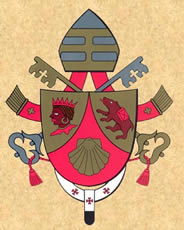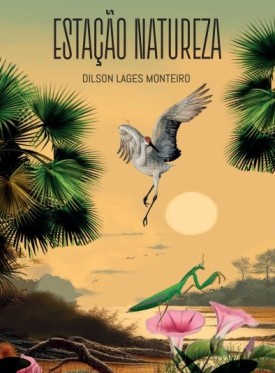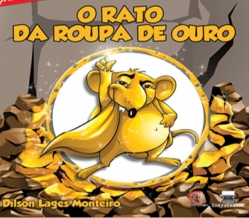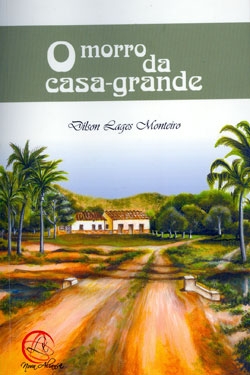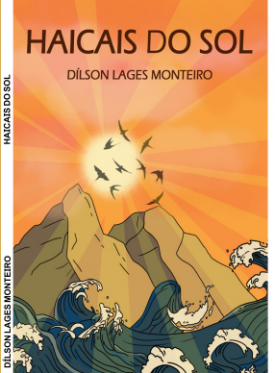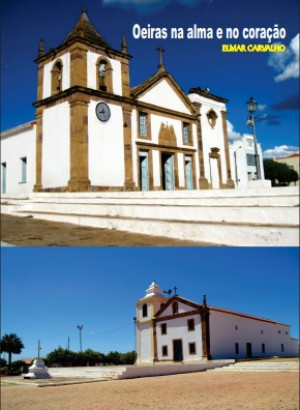Animais na heráldica (IV)
Há uma lhama branca no Escudo da Bolívia.
O Portal São Francisco generosamente informa-nos que, entre outros elementos heráldicos, há, no Brasão da Bolívia, "(...) um imagem típica do país, com o Monte Potosí ao fundo, uma lhama branca, uma árvore de fruta-pão e um pequeno barril de trigo (...)". Observe-se que não se omitiu a luta, que também acontece no plano dos Símbolos Nacionais, entre situação e oposição, naquele Nobre País latinoamericano: "(...) a oposição política ao atual governo renega essa simbologia. (...)". ["Essa simbologia" é a seguinte: 'Em 2005, um decreto presidencial determinou que o vermelho é o sangue do povo, o amarelo são as belezas naturais e o verde representa a esperança em dias melhores']. Sobre os resultados dessas curiosas "disputas paralelas" - que, no âmbito desta Coluna, são consideradas centrais -, aguardemos seus próximo resultados, com numa novela em se aguardam, ansiosamente, os "próximos capítulos". FB
Informa o referido Portal São Francisco, sobre o Brasão da Bolívia:
"(...) Até 2005, as cores da bandeira boliviana representavam a bravura do soldado boliviano (vermelho), a riqueza mineral (amarelo) e a fertilidade da terra (verde).
Em 2005, um decreto presidencial determinou que o vermelho é o sangue do povo, o amarelo são as belezas naturais e o verde representa a esperança em dias melhores. Mas a oposição política ao atual governo renega essa simbologia.

Brasão Boliviano
No centro, o brasão boliviano, com um escudo que tem a palavra BOLIVIA e nove estrelas douradas (que simbolizam os nove departamentos do país) na borda azul de um imagem típica do país, com o Monte Potosí ao fundo, uma lhama branca, uma árvore de fruta-pão e um pequeno barril de trigo.
Ladeando o escudo, seis bandeiras do país, dois canhões e quatro rifles (que representam a luta do povo pela independência), uma lança inca, uma semi-coroa de louros, um condor andino e um barrete frígio, uma espécie de touca que virou um símbolo da luta pela liberdade, já que os revolucionários franceses de 1789 usavam esse tipo de barrete". (http://www.portalsaofrancisco.com.br/alfa/bolivia/bandeira-da-bolivia.php)
===
A seguir, fotos de camelídeos, em blog em língua inglesa: alpacas, vicunhas, guanacos e lhamas podem ter, efetivamente, lã de cor branca. (DA MESMA FORMA QUE O PAPAGAIO IMPERIAL É UM SÍMBOLO NACIONAL DA DOMINICA, A LHAMA BRANCA, COMO SE CONCLUI, É UM SÍMBOLO NACIONAL BOLIVIANO).
"Tuesday, June 19, 2007
On Saturday Mike and I woke up early, readied several large cups of iced coffee and headed for Estes Park, which is not only the most picaresque drive I've ever been on, it lead to a fantastically gorgeous setting for the
Wool Market.
Because I took about a thousand pictures, I'll break up the post into pieces. In this installment we'll be touring the camelids.
We started with some carriage races. When I am king, I will have one of these and the alpacas or llamas to go with it.
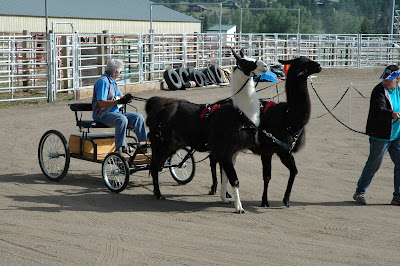
Mine will have spots, though. Lots and lots of spots. Like this one. I kind of like the blue merle color. I'd love to spin some of that and then knit it up. I imagine the outcome would blow your minds. Alas, my dreams of having a spotted alpaca drawn carriage are a long way off. Sometimes life just isn't fair.

These are paco-vicunas. They are cute and wee and oh so unbelievably soft. I would have run off with one, but they're not exactly easy to hide.
I learned a bit about them when Mike and I went to the lecture on ancient South American highlands culture. There's a vicuna on the
Peruvian flag (that's a close up of the crest). Their numbers are low because they've spent most of their history being killed for their soft bits. I think that's terribly rude, and I'm sure you do, too.

These ones were just babies and mostly sleepy. I was dumbfounded at every turn by how long all of their necks were. It's otherworldly and magnificent.

This one I named Old Blue Eyes for obvious reasons. The owner told us about how they don't generally breed for blue eyes because there is a propensity for deafness. I was reminded of small gene pools and royal families. I giggled out loud and when everybody turned toward me I sobered up and said, "I'm sorry. She's beautiful." And she is. Beautiful and really wicked cool. Wicked ... cool.

This one wore a bandana in order to indicate that it was a cowboy ... or cowgirl? In any case it was pretty damn cute.
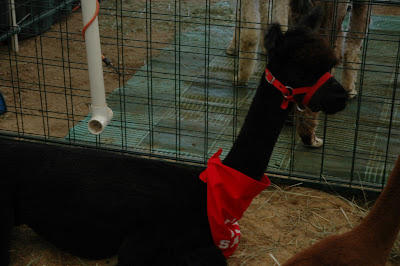
This one had no eyes and no legs, but look at that hair. This one was my favorite. It made faces at me. At no point did I see any eyes, but I did see lots and lots of teeth and a big smile. I named it Charlie. I figure that way we keep some gender neutrality and I like the idea of a llama named Chewy Charlie.

In this photo you can see the mountains in the background. It doesn't do the scenery justice, but it might give you an idea. It was just beautiful. The most important part of the photo though, is the little girl leading her llama up to the pole for the llama limbo they had. She made it really far, although she didn't win. Her llama followed her under and over this pole. It was cuter than cucumber sandwhiches and tea.

And here you see a slightly older girl, but still young, who had limited success with her llama. He would not jump, despite the pole not being of any great height at all. This was after the limbo, in which he was very cooperative, so I suspect he was just tired of following his little girl around. She should have given him a treat. Do llamas respond to treats? Surely they do.
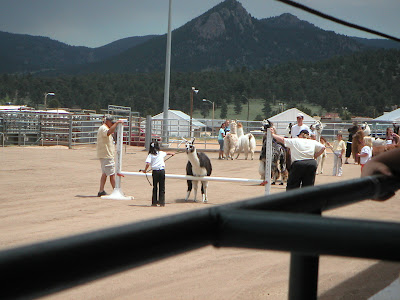
And these two ... well, they were just too cute. I think they're getting ready to grow up and be working pack animals. Their little baby packs are pretty ridiculous. I wanted to put my chapstick in them. Can you imagine?
Stranger: "What's that?"
Me: "Oh, that? That's just my chapstick alpaca or llama." (I promise I would find out exactly which animal I was allowing to tote around my chapstick.)
Stranger: "What?"
Me: "You know, I take him around with me so I have a place to put my chapstick. I mean, where do you keep your chapstick? In your pocket?" (followed by a loud snort and me walking off in a hauty manner."

And last but not least, a resting dark hairy llama. This one was very nice and didn't mind all of us strangers just walking up and poking at it. The poking wasn't malicious. It was more as a result of our reluctance to get too friendly with the llama, who didn't seem to have a person anywhere in sight.

The end .. for now. Next there will be photos of Mike being chased down, trampled and eaten by adorable yaks as well as Mike being gored by pointy horned goats.
p.s. I'm sure that I've butchered any and all information about these animals. Rest assured there will be even more butchering and a great showing of the less than little knowledge that I have about fiber bearing animals. I promise next year, I'll be far more informed.
 Mine will have spots, though. Lots and lots of spots. Like this one. I kind of like the blue merle color. I'd love to spin some of that and then knit it up. I imagine the outcome would blow your minds. Alas, my dreams of having a spotted alpaca drawn carriage are a long way off. Sometimes life just isn't fair.
Mine will have spots, though. Lots and lots of spots. Like this one. I kind of like the blue merle color. I'd love to spin some of that and then knit it up. I imagine the outcome would blow your minds. Alas, my dreams of having a spotted alpaca drawn carriage are a long way off. Sometimes life just isn't fair. These are paco-vicunas. They are cute and wee and oh so unbelievably soft. I would have run off with one, but they're not exactly easy to hide.
These are paco-vicunas. They are cute and wee and oh so unbelievably soft. I would have run off with one, but they're not exactly easy to hide. These ones were just babies and mostly sleepy. I was dumbfounded at every turn by how long all of their necks were. It's otherworldly and magnificent.
These ones were just babies and mostly sleepy. I was dumbfounded at every turn by how long all of their necks were. It's otherworldly and magnificent. This one I named Old Blue Eyes for obvious reasons. The owner told us about how they don't generally breed for blue eyes because there is a propensity for deafness. I was reminded of small gene pools and royal families. I giggled out loud and when everybody turned toward me I sobered up and said, "I'm sorry. She's beautiful." And she is. Beautiful and really wicked cool. Wicked ... cool.
This one I named Old Blue Eyes for obvious reasons. The owner told us about how they don't generally breed for blue eyes because there is a propensity for deafness. I was reminded of small gene pools and royal families. I giggled out loud and when everybody turned toward me I sobered up and said, "I'm sorry. She's beautiful." And she is. Beautiful and really wicked cool. Wicked ... cool. This one wore a bandana in order to indicate that it was a cowboy ... or cowgirl? In any case it was pretty damn cute.
This one wore a bandana in order to indicate that it was a cowboy ... or cowgirl? In any case it was pretty damn cute. This one had no eyes and no legs, but look at that hair. This one was my favorite. It made faces at me. At no point did I see any eyes, but I did see lots and lots of teeth and a big smile. I named it Charlie. I figure that way we keep some gender neutrality and I like the idea of a llama named Chewy Charlie.
This one had no eyes and no legs, but look at that hair. This one was my favorite. It made faces at me. At no point did I see any eyes, but I did see lots and lots of teeth and a big smile. I named it Charlie. I figure that way we keep some gender neutrality and I like the idea of a llama named Chewy Charlie. In this photo you can see the mountains in the background. It doesn't do the scenery justice, but it might give you an idea. It was just beautiful. The most important part of the photo though, is the little girl leading her llama up to the pole for the llama limbo they had. She made it really far, although she didn't win. Her llama followed her under and over this pole. It was cuter than cucumber sandwhiches and tea.
In this photo you can see the mountains in the background. It doesn't do the scenery justice, but it might give you an idea. It was just beautiful. The most important part of the photo though, is the little girl leading her llama up to the pole for the llama limbo they had. She made it really far, although she didn't win. Her llama followed her under and over this pole. It was cuter than cucumber sandwhiches and tea. And here you see a slightly older girl, but still young, who had limited success with her llama. He would not jump, despite the pole not being of any great height at all. This was after the limbo, in which he was very cooperative, so I suspect he was just tired of following his little girl around. She should have given him a treat. Do llamas respond to treats? Surely they do.
And here you see a slightly older girl, but still young, who had limited success with her llama. He would not jump, despite the pole not being of any great height at all. This was after the limbo, in which he was very cooperative, so I suspect he was just tired of following his little girl around. She should have given him a treat. Do llamas respond to treats? Surely they do. And these two ... well, they were just too cute. I think they're getting ready to grow up and be working pack animals. Their little baby packs are pretty ridiculous. I wanted to put my chapstick in them. Can you imagine?
And these two ... well, they were just too cute. I think they're getting ready to grow up and be working pack animals. Their little baby packs are pretty ridiculous. I wanted to put my chapstick in them. Can you imagine? And last but not least, a resting dark hairy llama. This one was very nice and didn't mind all of us strangers just walking up and poking at it. The poking wasn't malicious. It was more as a result of our reluctance to get too friendly with the llama, who didn't seem to have a person anywhere in sight.
And last but not least, a resting dark hairy llama. This one was very nice and didn't mind all of us strangers just walking up and poking at it. The poking wasn't malicious. It was more as a result of our reluctance to get too friendly with the llama, who didn't seem to have a person anywhere in sight. The end .. for now. Next there will be photos of Mike being chased down, trampled and eaten by adorable yaks as well as Mike being gored by pointy horned goats.
The end .. for now. Next there will be photos of Mike being chased down, trampled and eaten by adorable yaks as well as Mike being gored by pointy horned goats.




